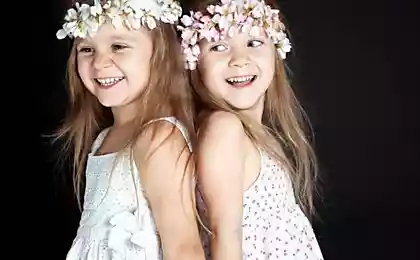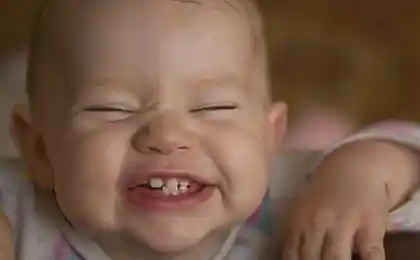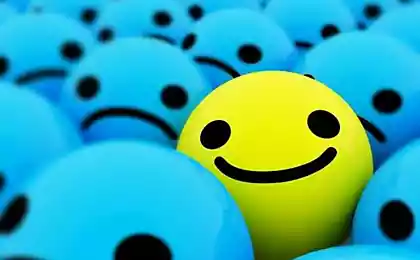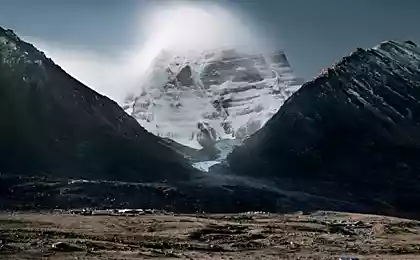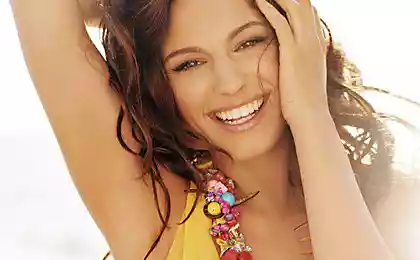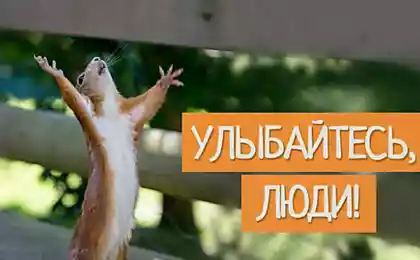581
Why we smile
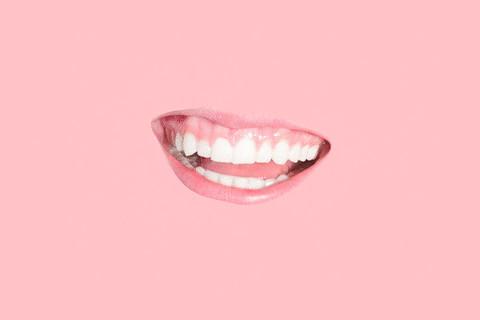
Long before spoken language, our ancestors communicated by using gestures. And now much of what we tell each other — nonverbally. But why are we rocks teeth when I want to Express friendliness? Why do we laugh? We offer You translation of the article about the theory of the origin of the smile.
Our emotional expressions seem innate, they are part of our evolutionary heritage. Nevertheless, their etymology remains a mystery. Can we track these social signals from the very beginning, from their evolutionary roots, to the behavior of our ancestors?
About ten years ago in the laboratory of Princeton University, we studied how the brain oversees the security zone around the body and controls the tilt, pouzivania, pridobivanje and other actions that keep us from the influence of others.
Our experiments were focused on the specific set of regions in the brain of man and monkeys. These areas of the brain immediately "processed" the space around the body, used sensory information and convert it into motion. We monitored the activity of individual neurons in those areas, trying to understand their function. When we watched our video, I noticed frightening similarities: the protective action of the monkeys was very similar to the standard human social signals. Why when you blow in the face of a monkey, her expression so strange like a human smile? Why laughing like we use some elements of protective racks?
As it turned out, we were not the first who looked for a relationship between the defensive movements and social behavior. Heini Hediger, curator of the Zurich zoo in 60 years, shared with us his insight. He was trying to figure out how to divide the space between zoo animals to meet their natural needs, and therefore sometimes ask for advice from the chief biologist of the zoo. And often he was surprised when he learned how animals interact with the surrounding space.
During an expedition to Africa where he caught the new specimens in the zoo, Hediger noticed a recurring pattern of behavior among the animals hunted by predators. Zebra, for example, not just escapes from the lion. Instead, it seems, builds up an invisible perimeter around him. While Leo is out of this perimeter, the Zebra is safe. When the lion crosses the border, Zebra changes location and restores it. If a lion is in the area of the smaller size, the Zebra runs away. I own zebras among themselves acting like a "protective zone", and although they are much smaller, they are treated with the respect it deserves. In a crowd of zebras never go close. They step and move so as to maintain minimum spaces between them.
In the 60 years of the American psychologist Edward Hall adapted the same idea to human behaviour. Hall found that every person has a protection zone with a width of 60-90 cm, extending to the head and tapering towards the feet. The zone no fixed size: if you are nervous, it grows, if you are relaxed, it shrinks. It also depends on your cultural upbringing. Personal space is less in Japan and more in Australia. Put the Japanese and Australian in the same room — followed by a strange dance: Japanese step forward, the Australian will take a step back, and so they will follow one after the other. Maybe not even paying attention to what is happening.
Hediger and Hall led us to an important discovery. The mechanism that we use to protect, also forms the basis of our social involvement. In the end, it organizes a kind of network within the social space.
Smile, one of the main tools of social interaction, is a very specific thing. The upper lip is raised to show the teeth. Cheeks spread out to the sides. The skin around the eyes wrinkles. Duchenne de Boulogne, a neuroscientist, who lived in the nineteenth century, noticed that cold, fake smile is often limited to the mouth, whereas a genuine, friendly smile always draws the eye. A sincere smile dushenkovsky is now named in his honor.
A smile can also indicate submission. Employees subject to someone, smile much more, being among the influential people. ("Sometimes, / Smiles, bows met / almost knelt down, As in the temple!", notes about Achille Patroclus in "Troilus and Cressida").
It only adds to the mystery. Why is the showing of teeth — a sign of friendliness? Why do it in a sign of submission? Unless the teeth do not need to testify about the aggression?
The majority of ethologists agree that a smile from the point of view of evolution is ancient and that its variants can be found among many primates. If you watch a group of monkeys, you will notice that they sometimes give each other what looks like a grimace. They communicate without aggression; ethologists call this the "silent demonstration of teeth." Some theorists argue that this gesture came from more or less the opposite — prepare for the attack.
But I think that focusing only on the teeth, they're missing out. In fact, this "demonstration of teeth" involves the whole body. Imagine two monkeys, A and B. Monkey B intersects the personal space of the monkey A. the Result? Two neurons that are responsible for monitoring personal space begins to crackle, appealing classic defensive response. The monkey looks up And squinted, shielding his eyes. Her upper lip tightened. It bares teeth, but it's just a side effect of: meaning of taut lips — not so much to prepare for an attack, but rather to tighten the skin on the face, slightly covering skin folds of the eye. Ears "depart" back, defending from damage. The head is retracted and the shoulders are raised to cover the vulnerable throat and neck. Head turns away from the impending object. The torso moves forward to protect the stomach. Depending on the location of the threat's hands can be crossed in front of the torso or the face. Monkeys often take a purely defensive stance, which protects the fragile and vulnerable parts of the body.
Monkey B can learn a lot, watching the reaction of the monkey A. If monkey And protected, as if fully responding to the actions of the monkey B, that is a good sign, indicating that the monkey And scared. It makes her uncomfortable. Her personal space invaded. She sees monkey B as an enemy, as someone superior to her socially. On the other hand, a monkey can answer "vaguely", almost screwing up his eyes and turning his head back. This means that the monkey is not particularly scared, she does not perceive the monkey B as socially superior or as an enemy.
This information is very helpful to the members of a social group. Monkey B can learn where to stand, and pay my respects to the monkey A. Thus, developing social signal; natural selection will favor the monkeys that can read the reaction of subordination in their group and adjust their behavior in accordance with them. By the way, is perhaps the most important part of the story: most of the evolutionary pressure falls on those who receive the signal, and not on those who sends. This story is about how we began to respond to the smile.
Often nature is an arms race. If monkey B can collect useful information by observing the monkey, the monkey is useful to manipulate this information to influence the monkey B. That is, the evolution prefers monkeys, which can under the right circumstances would like to play a defensive response. It is useful to convince others that you are not in jeopardy.
Look at the origin of the smile: it briefly flashed an imitation protective stand. There was only a stripped-down version, which involves facial muscles: the upper lip is tightened, the cheeks diverge to the sides and up, eye screw up one's eyes. Today we use it more to communicate with the position of friendly aggression than from a position of complete submission and cooperation.
And yet we can still observe the "monkey" gestures at himself. Sometimes we smile to show complete submission, and that servile smile may occur together with an echo of protective stands in the whole body: head down, shoulders up, torso lifted, hands in front of chest. Like monkeys, we respond to these signals automatically. We can't help but feel warmth towards those who radiate dushenkovsky smile. We can't help but feel contempt towards the man, who outwardly shows obedience, as well as can't help but be suspicious of those who simulates warmth soulless smile with cold eyes.
It's incredible that so much could come from such a simple root. Ancient protective mechanism, a mechanism that analyses the space around the body and organizes a defensive move, suddenly finds himself in a very social world of primates, surrounded by smiles, laughter, tears and flattery. Each of these types of behavior is then divided into several other in the whole code book of signals for use in different social conditions. Not all human expressions can be explained through this, but many. Businovskaya smile, cold smile, laughter over the joke, the laughter of appreciation for the smart sharpness, cruel laughter, groveling, designed to show reverence for someone, or straight back, showing the confidence, arms crossed, showing suspicion, open arms ("Welcome!"), a sad grimace, with which we show sympathy for someone's sad story — this whole set of expressions able to appear from one of a protective sensory-motor mechanism, which has nothing to do with communication.
Source: theoryandpractice.ru
In the Arctic found the wreckage of the missing 170 years ago of the ship of the Franklin expedition
Irish perpetual motion machine and mercury wheel monk







